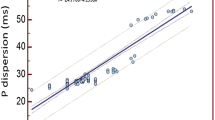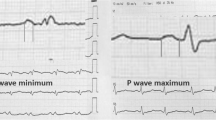Abstract
Some studies have been showed that electromechanical delay, which may pose an increased tendency to atrial fibrillation, may prolong in patients with various clinical conditions. In addition, the electromechanical delay in patients with secundum type atrial septal defect (ASD) compared to healthy people have been reported previously. Therefore, in the present study, we prospectively evaluated the mid-term and long-term effects of the transcatheter closure of secundum type ASD on the lateral atrial conduction time (PA), septal PA, tricuspid PA, left and right intra-atrial electromechanical delay (ILeft-EMD and IRight-EMD, respectively) and inter-atrial electromechanical delay (IA-EMD) measured by means of Doppler echocardiography. Our prospective study included a total of 45 secundum type ASD patients who undergone percutaneous transcatheter closure from December 2012 to April 2015. All patients underwent transthoracic echocardiography (TTE) before the closure, at sixth and twelfth months after the closure. In comparison of the EMD sixth months after the device closure, there were statistically significant decrease in lateral PA, septal PA, tricuspid PA, ILeft-EMD, IRight-EMD and IA-EMD compared to pre-device closure values. Twelfth months after the device closure, we also observed statistically significant decrease in lateral PA, septal PA, tricuspid PA, ILeft-EMD, IRight-EMD and IA-EMD compared to 6-month post-device closure values. In the present study, we observed that the atrial EMD improves after device closure and continues to improve after twelfth month following post-device closure.


Similar content being viewed by others
References
Abd El Rahman MY, Hui W, Timme J, Ewert P, Berger F, Dsebissowa F, Hetzer R, Lange PE, Abdul-Khaliq H (2005) Analysis of atrial and ventricular performance by tissue Doppler imaging in patients with atrial septal defects before and after surgical and catheter closure. Echocardiography 22(7):579–585
Kharouf R, Luxenberg DM, Khalid O, Abdulla R (2008) Atrial septal defect: spectrum of care. Pediatr Cardiol 29(2):271–280
Eerola A, Pihkala JI, Boldt T, Mattila IP, Poutanen T, Jokinen E (2007) Hemodynamic improvement is faster after percutaneous ASD closure than after surgery. Catheter Cardiovasc Interv 69(3):432–441
Du ZD, Hijazi ZM, Kleinman CS, Silverman NH, Larntz K, Amplatzer Investigators (2002) Comparison between transcatheter and surgical closure of secundum atrial septal defect in children and adults: results of a multicenter nonrandomized trial. J Am Coll Cardiol 39(11):1836–1844
Daubert JC, Pavin D, Jauvert G, Mabo P (2004) Intra- and interatrial conduction delay: implications for cardiac pacing. Pacing Clin Electrophysiol 27(4):507–525
Cagdas M, Velibey Y, Guvenc TS, Gungor B, Guzelburc O, Calik N, Ugur M, Tekkesin AI, Gurkan K, Eren M (2015) Evaluation of atrial electromechanical conduction delay in case of hemodynamically insignificant rheumatic heart disease: a tissue Doppler study. Cardiol J 22(6):683–690
Guo C, Liu J, Zhao S, Teng Y, Shen L (2016) Decreased left atrial strain parameters are correlated with prolonged total atrial conduction time in lone atrial fibrillation. Int J Cardiovasc Imaging 32(7):1053–1061
Rosenheck S (1997) Signal-averaged P wave in patients with paroxysmal atrial fibrillation. Pacing Clin Electrophysiol 20(10 Pt 2):2577–2586
Darbar D, Jahangir A, Hammill SC, Gersh BJ (2002) P wave signal-averaged electrocardiography to identify risk for atrial fibrillation. Pacing Clin Electrophysiol 25(10):1447–1453
Steinberg JS, Zelenkofske S, Wong SC, Gelernt M, Sciacca R, Menchavez E (1993) Value of the P-wave signal-averaged ECG for predicting atrial fibrillation after cardiac surgery. Circulation 88(6):2618 – 2622
Platonov PG, Carlson J, Ingemansson MP, Roijer A, Hansson A, Chireikin LV, Olsson SB (2000) Detection of interatrial conduction defects with unfiltered signal-averaged P-wave ECG in patients with lone atrial fibrillation. Europace 2(1):32–41
Erturk M, Aslam M, Aksu H, Akturk IF, Gul M, Uzun F, Surgit O, Ari H, Uslu N, Erol MK (2013) Evaluation of atrial electromechanic delay and left atrial functions in the patients with secundum type atrial septal defect. Echocardiography 30(6):699–705
Lang RM1, Bierig M, Devereux RB, Flachskampf FA, Foster E, Pellikka PA, Picard MH, Roman MJ, Seward J, Shanewise JS, Solomon SD, Spencer KT, Sutton MS, Stewart WJ, Chamber Quantification Writing Group; American Society of Echocardiography’s Guidelines and Standards Committee; European Association of Echocardiography (2005) Recommendations for chamber quantification: a report from the American Society of Echocardiography’s Guidelines and Standards Committee and the Chamber Quantification Writing Group, developed in conjunction with the European Association of Echocardiography, a branch of the European Society of Cardiology. J Am Soc Echocardiogr 18(12):1440–1463
Rudski LG, Lai WW, Afilalo J, Hua L, Handschumacher MD, Chandrasekaran K, Solomon SD, Louie EK, Schiller NB (2010) Guidelines for the echocardiographic assessment of the right heart in adults: a report from the American Society of Echocardiography endorsed by the European Association of Echocardiography, a registered branch of the European Society of Cardiology, and the Canadian Society of Echocardiography. J Am Soc Echocardiogr 23(7):685–713
Butera G, Carminati M, Chessa M, Youssef R, Drago M, Giamberti A, Pomè G, Bossone E, Frigiola A (2006) Percutaneous versus surgical closure of secundum atrial septal defect: comparison of early results and complications. Am Heart J 151(1):228–234
Kutty S, Hazeem AA, Brown K, Danford CJ, Worley SE, Delaney JW, Danford DA, Latson LA (2012) Long term (5 to 20 years) outcomes after transcatheter or surgical treatment of hemodynamically significant isolated secundum atrial septal defect. Am J Cardiol 109(9):1348–1352
Kaya Y, Yurtdaş M, Ceylan Y, Bulut MO, Söylemez N, Güvenç TS, Karakurt A, Akdemir R, Öztürk H, Güneş Y, Balcı B, Özkan M (2013) Erişkin ve çocuklardaki sekundum tip atriyal septal defektlerin perkütan yaklaşım ile kapatılması: Kısa – orta dönem izlem sonuçlarımız. Türk Kardiyol Dern Arş 41(8):705–713
Sadiq M, Kazmi T, Rehman A, Latif F, Hyder N, Qureshi SA (2012) Device closure of atrial septal defect: medium-term outcome with special reference to complications. Cardiol Young 22(1):71–78
Oto A, Aytemir K, Özkutlu S, Kaya BE, Kabakcı G, Ateş AH, Yorgun H, Canpolat U (2011) İnteratriyal septal defektlerin perkütan yolla kapatılması: Orta dönem izlem sonuçları. Türk Kardiyol Dern Arş 39(5):385–395
Chessa M, Carminati M, Butera G, Bini RM, Drago M, Rosti L, Giamberti A, Pome G, Bossone E, Frigiola A (2002) Early and late complications associated with transcatheter occlusion of secundum atrial septal defect. J Am Coll Cardiol 39(6):1061–1065
Sawa T, Tanaka H, Motoji Y, Hiraishi M, Mochizuki Y, Ryo K, Matsumoto K, Otake H, Shinke T, Hirata K (2016) Utility of isovolumic contraction peak velocity for evaluation of adult patient status after transcatheter closure of atrial septal defect. Echocardiography 33(1):23–29
Ağaç MT, Akyüz AR, Acar Z, Akdemir R, Korkmaz L, Kırış A, Erkuş E, Erkan H, Celik S (2012) Evaluation of right ventricular function in early period following transcatheter closure of atrial septal defect. Echocardiography 29(3):358–362
Knepp M, Rocchini A, Llyod T, Aiyagari R (2010) Long term follow up of secundum atrial septal defect closure with the Amplatzer septal occluder. Congenit Heart Dis 5(1):32–37
Santoro G, Pascotto M, Caputo S, Gaio G, Lacono C, Caso I, Sarubbi B, Carrozza M, Russo MG, Calabrò R (2008) Short term electrogeometric atrial remodeling after percutaneous atrial septal defect closure. J Cardiovasc Med 9(8):789–793
Balcı KG, Balcı MM, Aksoy MM, Yılmaz S, Aytürk M, Doğan M, Yeter E, Akdemir R (2015) Remodeling process in right and left ventricle after percutaneous atrial septal defect closure in adult patients. Turk Kardiyol Dern Ars 43(3):250–258
Ozer N, Yavuz B, Can I et al (2005) Doppler tissue evaluation of intraatrial and interatrial electromechanical delay and comparison with P-wave dispersion in patient with mitral stenosis. J Am Soc Echocardiogr 18:945–948
Aslan M, Erturk M, Turen S, Uzun F, Surgit O, Ozbay Ozyilmaz S, Rifat Yildirim M, Faruk Baycan O, Uygur B, Yildirim A, Eksik A (2014) Effects of percutaneous closure of atrial septal defect on left atrial mechanical and conduction functions. Eur Heart J Cardiovasc Imaging 15(10):1117–1124
Hessling G, Hyca S, Brockmeier K, Ulmer HE (2003) Cardiac dysrhythmias in pediatric patients before and 1 year after transcatheter closure of atrial septal defects using the Amplatzer septal occluder. Pediatr Cardiol 24:259–262
Author information
Authors and Affiliations
Corresponding author
Ethics declarations
Conflict of interest
The authors declare that they do not have any conflicts of interest.
Rights and permissions
About this article
Cite this article
Öz, A., Aruğaslan, E., Çınar, T. et al. Long term evaluation of electromechanical delay in patients with atrial septal defect after transcatheter closure. Int J Cardiovasc Imaging 35, 33–39 (2019). https://doi.org/10.1007/s10554-018-1426-x
Received:
Accepted:
Published:
Issue Date:
DOI: https://doi.org/10.1007/s10554-018-1426-x




